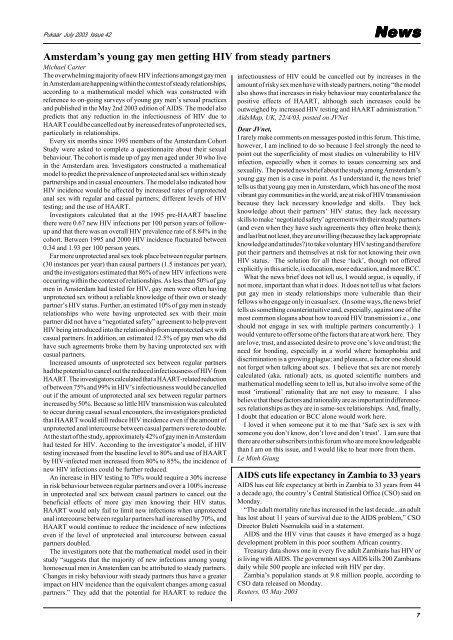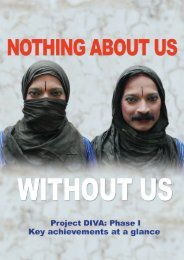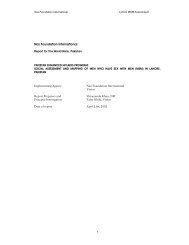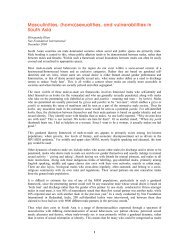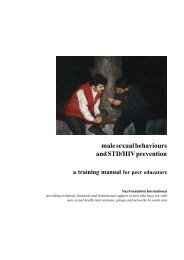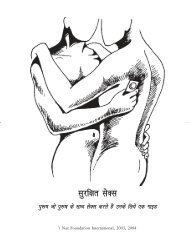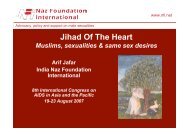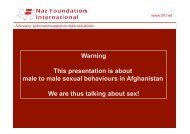Features - Naz Foundation International
Features - Naz Foundation International
Features - Naz Foundation International
Create successful ePaper yourself
Turn your PDF publications into a flip-book with our unique Google optimized e-Paper software.
Pukaar July 2003 Issue 42<br />
News<br />
Amsterdam’s young gay men getting HIV from steady partners<br />
Michael Carter<br />
The overwhelming majority of new HIV infections amongst gay men<br />
in Amsterdam are happening within the context of steady relationships,<br />
according to a mathematical model which was constructed with<br />
reference to on-going surveys of young gay men’s sexual practices<br />
and published in the May 2nd 2003 edition of AIDS. The model also<br />
predicts that any reduction in the infectiousness of HIV due to<br />
HAART could be cancelled out by increased rates of unprotected sex,<br />
particularly in relationships.<br />
Every six months since 1995 members of the Amsterdam Cohort<br />
Study were asked to complete a questionnaire about their sexual<br />
behaviour. The cohort is made up of gay men aged under 30 who live<br />
in the Amsterdam area. Investigators constructed a mathematical<br />
model to predict the prevalence of unprotected anal sex within steady<br />
partnerships and in casual encounters. The model also indicated how<br />
HIV incidence would be affected by increased rates of unprotected<br />
anal sex with regular and casual partners; different levels of HIV<br />
testing; and the use of HAART.<br />
Investigators calculated that at the 1995 pre-HAART baseline<br />
there were 0.67 new HIV infections per 100 person years of followup<br />
and that there was an overall HIV prevalence rate of 8.84% in the<br />
cohort. Between 1995 and 2000 HIV incidence fluctuated between<br />
0.34 and 1.93 per 100 person years.<br />
Far more unprotected anal sex took place between regular partners<br />
(30 instances per year) than causal partners (1.5 instances per year),<br />
and the investigators estimated that 86% of new HIV infections were<br />
occurring within the context of relationships. As less than 50% of gay<br />
men in Amsterdam had tested for HIV, gay men were often having<br />
unprotected sex without a reliable knowledge of their own or steady<br />
partner’s HIV status. Further, an estimated 10% of gay men in steady<br />
relationships who were having unprotected sex with their main<br />
partner did not have a “negotiated safety” agreement to help prevent<br />
HIV being introduced into the relationship from unprotected sex with<br />
casual partners. In addition, an estimated 12.5% of gay men who did<br />
have such agreements broke them by having unprotected sex with<br />
casual partners.<br />
Increased amounts of unprotected sex between regular partners<br />
had the potential to cancel out the reduced infectiousness of HIV from<br />
HAART. The investigators calculated that a HAART-related reduction<br />
of between 75% and 99% in HIV’s infectiousness would be cancelled<br />
out if the amount of unprotected anal sex between regular partners<br />
increased by 50%. Because so little HIV transmission was calculated<br />
to occur during casual sexual encounters, the investigators predicted<br />
that HAART would still reduce HIV incidence even if the amount of<br />
unprotected anal intercourse between casual partners were to double.<br />
At the start of the study, approximately 42% of gay men in Amsterdam<br />
had tested for HIV. According to the investigator’s model, if HIV<br />
testing increased from the baseline level to 80% and use of HAART<br />
by HIV-infected men increased from 80% to 85%, the incidence of<br />
new HIV infections could be further reduced.<br />
An increase in HIV testing to 70% would require a 30% increase<br />
in risk behaviour between regular partners and over a 100% increase<br />
in unprotected anal sex between casual partners to cancel out the<br />
beneficial effects of more gay men knowing their HIV status.<br />
HAART would only fail to limit new infections when unprotected<br />
anal intercourse between regular partners had increased by 70%, and<br />
HAART would continue to reduce the incidence of new infections<br />
even if the level of unprotected anal intercourse between casual<br />
partners doubled.<br />
The investigators note that the mathematical model used in their<br />
study “suggests that the majority of new infections among young<br />
homosexual men in Amsterdam can be attributed to steady partners.<br />
Changes in risky behaviour with steady partners thus have a greater<br />
impact on HIV incidence than the equivalent changes among casual<br />
partners.” They add that the potential for HAART to reduce the<br />
infectiousness of HIV could be cancelled out by increases in the<br />
amount of risky sex men have with steady partners, noting “the model<br />
also shows that increases in risky behaviour may counterbalance the<br />
positive effects of HAART, although such increases could be<br />
outweighed by increased HIV testing and HAART administration.”<br />
AidsMap, UK, 22/4/03, posted on JVNet<br />
Dear JVnet,<br />
I rarely make comments on messages posted in this forum. This time,<br />
however, I am inclined to do so because I feel strongly the need to<br />
point out the superficiality of most studies on vulnerability to HIV<br />
infection, especially when it comes to issues concerning sex and<br />
sexuality. The posted news brief about the study among Amsterdam’s<br />
young gay men is a case in point. As I understand it, the news brief<br />
tells us that young gay men in Amsterdam, which has one of the most<br />
vibrant gay communities in the world, are at risk of HIV transmission<br />
because they lack necessary knowledge and skills. They lack<br />
knowledge about their partners’ HIV status; they lack necessary<br />
skills to make ‘negotiated safety’ agreement with their steady partners<br />
(and even when they have such agreements they often broke them);<br />
and last but not least, they are unwilling (because they lack appropriate<br />
knowledge and attitudes?) to take voluntary HIV testing and therefore<br />
put their partners and themselves at risk for not knowing their own<br />
HIV status. The solution for all these ‘lack’, though not offered<br />
explicitly in this article, is education, more education, and more BCC.<br />
What the news brief does not tell us, I would argue, is equally, if<br />
not more, important than what it does. It does not tell us what factors<br />
put gay men in steady relationships more vulnerable than their<br />
fellows who engage only in casual sex. (In some ways, the news brief<br />
tells us something counterintuitive and, especially, against one of the<br />
most common slogans about how to avoid HIV transmission i.e., one<br />
should not engage in sex with multiple partners concurrently.) I<br />
would venture to offer some of the factors that are at work here. They<br />
are love, trust, and associated desire to prove one’s love and trust; the<br />
need for bonding, especially in a world where homophobia and<br />
discrimination is a growing plague; and pleasure, a factor one should<br />
not forget when talking about sex. I believe that sex are not merely<br />
calculated (aka. rational) acts, as quoted scientific numbers and<br />
mathematical modelling seem to tell us, but also involve some of the<br />
most ‘irrational’ rationality that are not easy to measure. I also<br />
believe that these factors and rationality are as important in differencesex<br />
relationships as they are in same-sex relationships. And, finally,<br />
I doubt that education or BCC alone would work here.<br />
I loved it when someone put it to me that ‘Safe sex is sex with<br />
someone you don’t know, don’t love and don’t trust’. I am sure that<br />
there are other subscribers in this forum who are more knowledgeable<br />
than I am on this issue, and I would like to hear more from them.<br />
Le Minh Giang<br />
AIDS cuts life expectancy in Zambia to 33 years<br />
AIDS has cut life expectancy at birth in Zambia to 33 years from 44<br />
a decade ago, the country’s Central Statistical Office (CSO) said on<br />
Monday.<br />
“The adult mortality rate has increased in the last decade...an adult<br />
has lost about 11 years of survival due to the AIDS problem,” CSO<br />
Director Buleti Nsemukila said in a statement.<br />
AIDS and the HIV virus that causes it have emerged as a huge<br />
development problem in this poor southern African country.<br />
Treasury data shows one in every five adult Zambians has HIV or<br />
is living with AIDS. The government says AIDS kills 200 Zambians<br />
daily while 500 people are infected with HIV per day.<br />
Zambia’s population stands at 9.8 million people, according to<br />
CSO data released on Monday.<br />
Reuters, 05 May 2003<br />
7


